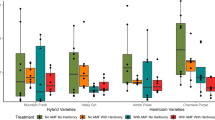Abstract
Previous research identified the presence of unique semivolatile compounds in alfalfa weevil (Hypera postica Gyllenhal) (AW) -resistantMedicago accessions. These compounds may impart repellency to AW in alfalfa (Medicago sativa L.). The objective of our study was to analyze within- and between-population variation for four of these unique semivolatile compounds across eglandular and glandular-hairedMedicago accessions. SevenMedicago accessions were evaluated under greenhouse conditions in an experiment arranged as randomized complete blocks with four replicates. Volatile compounds were extracted via supercritical fluid extraction and then quantitatively analyzed for levels of 2,7-dimethyl, 2,6-octadienol;cis-geraniol; 1,(E)-8,(Z)-10-tetradecatriene; and 1-hepten-3-ol. Significant difference (P<0.05) among entries were observed for 2,7-dimethyl,2,6-octadienol;cis-geraniol; 1, and (E)-8,(Z)-10-tetradecatriene. These compounds were found only in glandularhaired accessions. There were no significant differences in levels of 1-hepten-3-ol. Our findings demonstrate that the genetic incorporation of 2,7-dimethyl, 2,6-octadienol;cis-geraniol; 1, and (E)-8,(Z)-10-tetradecatriene into cultivated alfalfa will require interspecific crossing. Alfalfa weevil behavioral tests using these compounds must be conducted prior to such crosses in order to ascertain the efficacy of repellency by these compounds.
Similar content being viewed by others
References
Anonymous, 1984. What do the guidelines mean?Tufts Univ. Diet Nutr. Lett. 2(2):7–8.
Barnes, D. K., andRatcliffe, R. H. 1969. Evaluation of annual species ofMedicago as sources of alfalfa weevil resistance.Crop Sci. 9:640–642.
Core, R. J., Henning, J. A., andGardea-Torresdey, J. L. 1994. Volatile compounds fromMedicago Spp. as potential signals for alfalfa weevil response.J. Agric. Food Chem. 42:2932–2936.
Danielson, S. D., Manglitz, G. R., andSorensen, E. L. 1986. Development of alfalfa weevil (Coleoptera: Curculionidae) larvae when reared on perennial glandular-hairedMedicago species in the greenhouse.Environ. Entomol. 15:396–398.
Danielson, S. D., Manglitz, G. R., andSorensen, E. L. 1987a. Resistance of perennial glandular-hairedMedicago species to oviposition by alfalfa weevils (Coleoptera: Curculionidae).Environ. Entomol. 16:195–197.
Danielson, S. D., Manglitz, G. R., andSorensen, E. L. 1987b. Resistance in perennial glandular-hairedMedicago species to feeding by adult alfalfa weevils (Coleoptera: Curculionidae).Environ. Entomol. 16:708–711.
Doss, R. P., andJohnson, K. J. R. 1991. (Z)-Oxacyclotridec-10-en-2-one does not appear to be responsible for resistance to adult alfalfa weevil feeding exhibited byMedicao rugosa.J. Chem. Ecol. 17:535–542.
Doss, R. P., Gould, S. J., Johnson, K. J. R., Flath, R. A., andKohnert, R. L. 1989. (Z)-Oxacyclotridec-10-en-2-one, an alfalfa feeding deterrent fromMedicago rugosa.Phytochemistry 28:3311–3315.
Goodwin, T. W., andMercer, E. I. 1983. Introduction to Plant Biochemistry, 2nd ed. Pergamon Press, New York.
Hawthorne, S. B., Krieger, M. S., andMiller, D. J. 1988. Analysis of flavor and fragrance compounds using supercritical fluid extraction coupled with gas chromatography.Anal. Chem. 60:472–477.
Hedin, P. A., Ellsbury, M. M., andDysart, R. J. 1988. Volatiles from clover headHypera meles (Fab.) and alfalfaH. postica (Gyllenhal) weevils: Search for pheromones.Experientia 44:792–794.
Henning, J. A., Core, R. J., andGardea-Torresdey, J. L. 1994. Extracting volatile compounds from single plants using supercritical fluid extraction.Crop Sci. 34:1120–1122.
Hodgson, P., andPosler, G. L. 1986. Alfalfa fights back: Wild and hairy strains courted.Crops Soils Mag. 39:5–6.
Hsiao, T. H. 1993. Geographic and genetic variation among alfalfa weevil strains, pp. K. C. Kim and B. A. McPheron (eds.).in Evolution of Insect Pests: The Pattern of Variation; John Wiley & Sons, New York.
Johnson, K. J. R., Sorensen, E. L., andHorber, E. K. 1980a. Resistance in glandular-haired annualMedicago species to feeding by adult alfalfa weevils (Hypera postica).Environ. Entomol. 9:133–136.
Johnson, K. J. R., Sorensen, E. L., andHorber, E. K. 1980b. Resistance of glandular-hairedMedicago species to oviposition by alfalfa weevils (Hyperapostica).Environ. Entomol. 9:241–244.
Johnson, K. J. R., Sorensen, E. L., andHorber, E. K. 1981. Behavior of adult alfalfa weevils (Hypera postica) on resistant and susceptibleMedicago species in free-choice preference tests.Environ. Entomol. 10:580–585.
Keith, D. L.,Manglitz, G. R., andKehr, W. R. 1982. The Alfalfa Weevil.Nebr. Ext. Sen: NebGuide G73–G80.
Kennedy, G. C., Gould, F., Deponti, O. M. B., andStinner, R. E. 1987. Ecological, agricultural, genetic and commercial considerations in the deployment of insect-resistant germplasm.Environ. Entomol. 16:327–338.
Manglitz, G. R., andRatcliffe, R. H. 1988. Insects and mites.Am. Soc. Agron. Monogr. 29:671–704.
Moffett, J. O., Harvey, J., andCox, R. 1986. Effect of a sticker on the toxicity of Penncap-M and Furadan to Honey Bees when these insecticides were sprayed on flowering alfalfa.J. Entomol. Sci. 21:294–300.
Shade, R. E., Thompson, T. E., andCampbell, W. R. 1975. An alfalfa weevil larval resistance mechansism detected inMedicago.J. Econ. Entomol. 68:399–404.
Snedecor, G. W., andCochran, W. G. 1980. Statistical Methods, 7th ed. The Iowa State University Press. Ames.
Sorensen, E. L., Horber, E. K., andStuteville, D. L. 1985. Registration of KS108GH5 glandular-haired germplasm with multiple pest resistance.Crop Sci. 25:1132.
Sorensen, E. L., Horber, E. K., andStuteville, D. L. 1986. Registration of KS94GH6 glandular-haired alfalfa germplasm with multiple pest resistance.Crop Sci. 26:1088.
Author information
Authors and Affiliations
Rights and permissions
About this article
Cite this article
Core, R.J., Henning, J.A., Gardea-Torresdey, J. et al. Quantitative comparison of volatile compounds among sevenMedicago spp. accessions. J Chem Ecol 22, 1621–1627 (1996). https://doi.org/10.1007/BF02272402
Received:
Accepted:
Issue Date:
DOI: https://doi.org/10.1007/BF02272402



